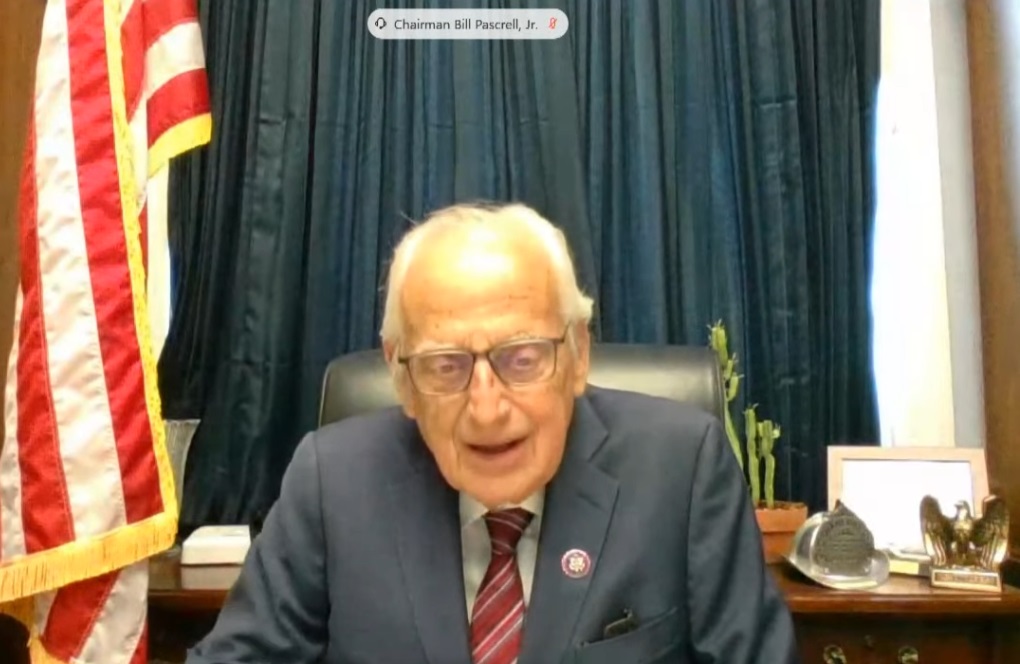Pascrell Eyes Higher Education Expansion

U.S. Rep. Bill Pascrell (D-8) chaired a subcommittee virtual meeting of the Ways and Means Committee to discuss expanding access to higher education. Among the experts brought on board to provide insights and policy recommendations was Dr. Steven M. Rose, the president of Passaic County Community College.
Pascrell began by asserting the importance of higher education as a venue for upward mobility. “Study after study has documented how higher education helps Americans get good paying jobs, support a decent home, and comfortably raise a family. Higher education is a gateway to the middle class. Yet, for many young people, especially those of color and from low-income backgrounds, significant barriers to higher education exist. Those barriers may have even multiplied over the pandemic. Thanks to Congressman Jimmy Gomez and Senator Bob Menendez, our bill to make student loan and debt forgiveness tax free through 2025 passed in the American Rescue Plan, but we need to examine how else we can help students.”
Pascrell’s invited guests to provide testimonies included Dr. Marshall Anthony Jr., Senior Policy Analyst, Center for American Progress; Dr. Susan Whealler Johnston, President and Chief Executive Officer, National Association of College and University Business Officers; Dr. Susan M. Dynarski, Professor of Public Policy, Education, and Economics, University of Michigan; and Mr. Scott Pulsipher, President, Western Governors University, an entirely online university.
Specifically referring to the tax code, Pascrell asked the guests if there were ways to use the code to help students receive higher education. He said, “we face a titanic crisis” with regards to “crippling student loan debt.” The chairman said that student loan debt totals about $1.7 trillion and that the average debt load is $38,000 on 45 million student borrowers. “This often delays recent graduates from buying homes, starting families, and moving into the middle class. It is a challenge of our time. We must understand why the cost of college is outpacing the other costs in the economy. We must offer more relief for those struggling to pay their education. As we return to normalcy, it is also appropriate to look at how the pandemic has affected our institutions of higher learning… including their ability to provide an affordable education to all students.”
Dr. Anthony spoke first and provided some background on his own academic experience as a student. “As a young black man from a low-income single-parent household, I received the maximum Pell grant throughout my undergraduate studies to help pay for college.” But he said he was not receiving enough financial aid to cover other necessities. “That meant when I should’ve been sleeping, I spent countless hours staring at the ceiling worrying about expensive course materials that professors required me to purchase, it also meant canceling my bill plan in order to pay for gas to get to class and participating in internships. And it meant chipping in at times to help my family pay utility bills… but far too many of the black, brown, low income, and students with disabilities never make it to the graduation stage to collect their diplomas.”
Dr. Anthony said that many students are also working and taking care of their families while attending classes. “They are juggling demands that would strike you or I as nearly impossible… Never before has a college degree been so necessary to make it in this country.”
Dr. Anthony outlined “four troubling facts.” The first was the decline in the Pell grant’s coverage. ‘Fifty years ago they covered almost 80% of costs at 4 year institutions, today the maximum is less than a third.” He said that students also have to work while taking classes to get by. Dr. Anthony made his third point saying that community colleges are underfunded and can’t adequately serve low income and minority students who are more likely to attend community colleges, a topic Dr. Rose would expand upon later. The last point Dr. Anthony made was that public education was already in trouble before the pandemic. Previously, the pandemic only a few states recovered from the Great Recession.
“These are just a few of the reasons why so many students leave college with no degree and debt they cannot repay,” Dr. Anthony said. “Black borrowers who are hard hit by employment discrimination and have nearly ten times less wealth than white families, are most likely to suffer. The system has failed too many students. The ability to graduate should not be conditional upon a student, such as myself, having good fortune, if you want to call it that.”
Dr. Anthony called for a more equitable system by better supporting students, investing in community colleges, and limiting debt.
Dr. Susan Whealler Johnston, provided her testimony, outlining some more proposals Congress could consider. “In the last academic year, nearly 90% of first year undergraduates received institutional financial aid and it covered more than half their tuition and fees on average. Federal policies can be strengthened so they can aid students with the cost of college. Charitable giving should be encouraged. Policies that discourage giving and take charitable resources away to education like the tax on net investment income should be reversed. Federal tax credits that ultimately lower the cost of college should be improved.”
Closer to home to Congressman Pascrell then introduced a familiar face, Dr. Steven M. Rose. “When I arrived [in 1987] we had approximately 2000 students per year and currently we serve over 11,000,” Dr. Rose said. “This growth is fairly typical of community colleges during this timespan. Eighty percent of our students are minorities with many having English as their second language. Many are enrolled to seek an associate degree for transfer into a baccalaureate institution or direct entry into a career such as a registered nurse. Others come seeking our workforce development program leading to industry recognized credentials in healthcare and technology fields. The topic of this hearing, expanding access to higher education and the promise it holds, this is why community colleges were created.”
Dr. Rose said that many students are the first in their family to enter higher education and echoed Pascrell’s words that education is the path to the middle class.
“The financial support our college and students received from the federal government was necessary and impactful. I am not exaggerating that the aid many students received was life sustaining and life changing.” Dr. Rose added that typically when the job market is strong, community college enrollment declines, and that they had been witnessing such a trend in Passaic County since 2012. In 2017, a large dip in enrollment took place when DACA and undocumented students “no longer felt comfortable attending college due to the national debate on immigration.”
Over the past year, enrollment declined over 17%. “Most of the decline came from newly enrolled students rather than continuing students.” That being said, the decline was not universally distributed. He said that the fall 2020 semester saw a “relatively minor” decline from more affluent school districts, but the loss of students from urban areas was down 50%. “In our discussion with these districts, it was clear that these students did not go elsewhere, they just did not go to college… many urban high schools reported that students stopped attending remote classes at some point and many will not be graduating. In some cases, the districts reported that they have totally lost touch with these students.”
Because of the difficulties of the past year, many students going into Passaic County Community College are more academically behind than ever before. “College graduation rates could be hurt for years to come. I believe I can speak for all community colleges when I say that we will do whatever necessary. While the challenges are daunting, the cost of failing is far too great.”
Congressman Pascrell questioned Dr. Rose, saying that Congress needed the expertise of academia to understand how the pandemic has affected students and their readiness for college.
“One of the schools you are very familiar with, our own Kennedy High School [in Paterson], we saw a 50% decline in the number of students last fall who enrolled here than normally do,” Dr. Rose replied. “That’s devastating. That’s also true of Passaic High School and several other urban high schools, but the suburban high schools were relatively unchanged from previous years. There’s obviously something going on when you look at the difference between the urban and suburban schools. Our numbers are off again for Fall 2021, it looks like many of them are going to be starting further behind than is typical. They’re going to need more developmental classes in order to try to catch them up and that’s going to affect these students in years to come.”
Every school district was impacted by the pandemic, although Governor Murphy had encouraged schools to revert to in-person instruction at the earliest opportunity. This week, Trenton announced that districts would be free to determine on their own whether or not masks would be required in schools. But the virus did not discriminate who was affected, necessitating colleges to work remotely as well. Pascrell asked if PCCC was ready for the return to in person programs. Dr. Rose said they were, but that there were many students not graduating from high school, so to try to incentivize them to start college, a free GED program was being offered. “We are talking to the staff every day. Anything they need, we are ready to step up and try to catch these students up so they can start college this fall and be ready.”
Pascrell asked if Dr. Rose was an advocate of the school STEM programs. He said yes, but that one of the problems they faced was that it was essential to work with students at a young age to be sure they would be ready for a STEM related career.
“The STEM program to me is our way out and one of our engines,” Pascrell said, “we’re missing the boat if we don’t support you guys. I understand that the tuition is free for students with family incomes below $65,000.”
“That is correct, that’s a new program in New Jersey, the Community College Opportunity Grants,” Dr. Rose confirmed.
Streamlining and simplifying the grant application process was discussed at length during the meeting, and that confusing and intimidating paperwork was a severe hindrance to students getting the assistance they needed and could potentially get.
“It has to be simple,” Dr. Rose said. “We have so many students who would qualify for a Pell grant, but they can’t get through the application process. They get thrown into this morass of verification… and that’s the only way they can get financial aid… we have to keep it simple. Things like the American Opportunity Tax Credit, it’s a wonderful program, but I have never once heard a student say I can now afford college because of a refundable tax credit. That’s not why they come. They come because we have a simple message.”
Dr. Rose praised the state’s community college opportunity grant. “We can say if your family income is under $65,000 you can attend college for free, that’s the kind of message we have to send.”
“That’s what we need, ‘just keep it simple’,” Pascrell said. “We should tell that to the Congress of the United States. We have a problem doing that.”
When Congressman Jimmy Panetta (CA CD20) addressed Dr. Rose, he said that he and his older brothers were products of community colleges. From there, he said that they were then able to pay their way through four-year colleges. “As we know, traditionally, [community college] was more of a state purview, and I’m so glad that our federal government is actually taking interest in our community colleges.” He asked Dr. Rose how the federal government can better support community colleges.
“I think we need a simple message that it is affordable to students,” Dr. Rose said. “When we are talking to students, they have to have a message that they can go to college. If they know that that is a possibility for them, they’ll start taking the right courses… we can’t count on someone else to deliver that message. If they get that message we will get more of these students into college, I don’t think it’s that complicated.”
“In what ways does Passaic support non-traditional students and how are they more accessible to students who work or take care of families?” Panetta asked.
“That’s basically all our students,” Dr. Rose said. “You can be 18 years old but it doesn’t mean you’re a traditional student.” Faculties needed to be trained to be flexible and understand that working students may have time issues that can impact their classes. Further, he said that Passaic County Community College sought to address further issues faced by low-income students by hiring social workers. “For the first time we have hired social workers in addition to our counseling staff. A social worker approaches things from a very different point of view and students have problems, problems with homelessness, and if we have staff who can help them then that’s going to make all the difference in the world.”
Congressman Panetta said that many community colleges serve students who need language perfection in order to succeed. Dr. Rose was proud to point out that PCCC established a campus in downtown Paterson to be in the areas where the need for ESL was most strongly felt and that this served as a way to integrate the college with the community and strengthen it.
With colleges forced to face their own fixed expenses, combined with added costs related to the pandemic on top of declining enrollments, New Jersey’s community college approach—and with Passaic County Community College as but one example—may serve for a template for some other states to consider with respect to giving low-income students a more realistic chance of enrolling and graduating. On the federal level, discussions have been taking place regarding abolishing certain amounts of student loan debt held by borrowers, but the root causes of why higher education has skyrocketed remain to be had as a meaningful national conversation. Lawmakers will also need to contend with the philosophical and constitutional challenges federal involvement with education may present, ensuring that any approach taken is bound to be a slow and arduous journey through the halls of government. In the meantime, students and former students will continue to shoulder the costs which consequently handicap the nation’s potential overall prosperity.










Leave a Reply